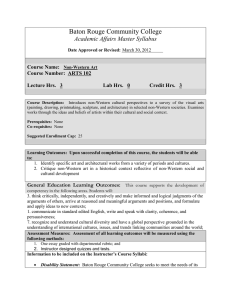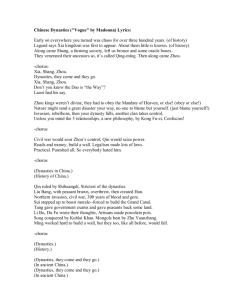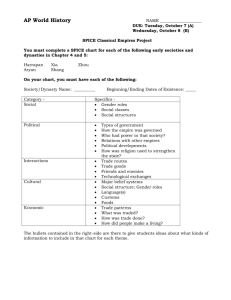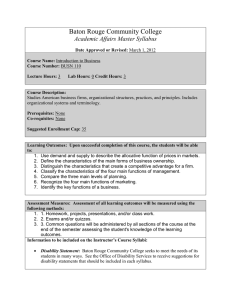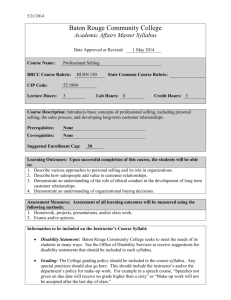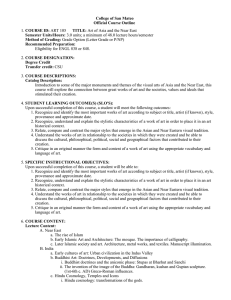Baton Rouge Community College Academic Affairs Master Syllabus
advertisement
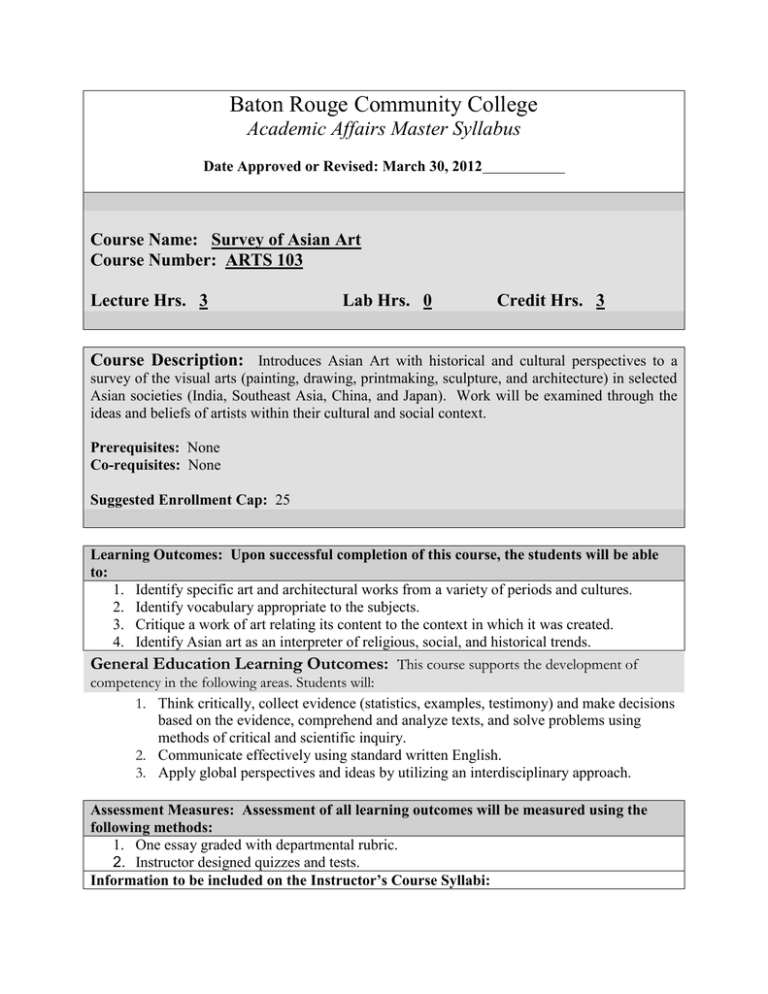
Baton Rouge Community College Academic Affairs Master Syllabus Date Approved or Revised: March 30, 2012 Course Name: Survey of Asian Art Course Number: ARTS 103 Lecture Hrs. 3 Lab Hrs. 0 Credit Hrs. 3 Course Description: Introduces Asian Art with historical and cultural perspectives to a survey of the visual arts (painting, drawing, printmaking, sculpture, and architecture) in selected Asian societies (India, Southeast Asia, China, and Japan). Work will be examined through the ideas and beliefs of artists within their cultural and social context. Prerequisites: None Co-requisites: None Suggested Enrollment Cap: 25 Learning Outcomes: Upon successful completion of this course, the students will be able to: 1. Identify specific art and architectural works from a variety of periods and cultures. 2. Identify vocabulary appropriate to the subjects. 3. Critique a work of art relating its content to the context in which it was created. 4. Identify Asian art as an interpreter of religious, social, and historical trends. General Education Learning Outcomes: This course supports the development of competency in the following areas. Students will: 1. Think critically, collect evidence (statistics, examples, testimony) and make decisions based on the evidence, comprehend and analyze texts, and solve problems using methods of critical and scientific inquiry. 2. Communicate effectively using standard written English. 3. Apply global perspectives and ideas by utilizing an interdisciplinary approach. Assessment Measures: Assessment of all learning outcomes will be measured using the following methods: 1. One essay graded with departmental rubric. 2. Instructor designed quizzes and tests. Information to be included on the Instructor’s Course Syllabi: Disability Statement: Baton Rouge Community College seeks to meet the needs of its students in many ways. See the Office of Disability Services to receive suggestions for disability statements that should be included in each syllabus. Grading: The College grading policy should be included in the course syllabus. Any special practices should also go here. This should include the instructor’s and/or the department’s policy for make-up work. For example in a speech course, “Speeches not given on due date will receive no grade higher than a sixty” or “Make-up work will not be accepted after the last day of class.” Attendance Policy: Include the overall attendance policy of the college. Instructors may want to add additional information in individual syllabi to meet the needs of their courses. General Policies: Instructors’ policy on the use of things such as beepers and cell phones and/or hand held programmable calculators should be covered in this section. Cheating and Plagiarism: This must be included in all syllabi and should include the penalties for incidents in a given class. Students should have a clear idea of what constitutes cheating in a given course. Safety Concerns: In some programs this may be a major issue. For example, “No student will be allowed in the safety lab without safety glasses.” General statements such as, “Items that may be harmful to one’s self or others should not be brought to class.” Library/ Learning Resources: Since the development of the total person is part of our mission, assignments in the library and/or the Learning Resources Center should be included to assist students in enhancing skills and in using resources. Students should be encouraged to use the library for reading enjoyment as part of lifelong learning. Expanded Course Outline: I. Early Culture and Art: The Stone Age, Bronze Age, and Early Iron Age A. Urban Civilization and the Indus Valley 1. Neolithic and Pre-Shang China 2. Ban Chieng Culture (Thailand) B. Chinese Art from the Shang and Middle Zhou periods C. Late Zhou Period 1. Confucianism 2. Daoism D. Qin and Han dynasty E. Korea and Japan II. International Influence of Buddhist art A. Origin of Buddhism B. Early Art in India C. International Gupta Style D. Expansion of Buddhist Art to East Asia III. The Rise of National Indian and Indonesian styles A. Early Hindu Art in India B. Early Medieval Hindu Art in South and Central India C. Later Medieval Hindu D. The Medieval Art of Southeast Asia and Indonesia IV. Chinese Painting A. Early dynasties 1. Xia Dynasty 2. Shang 3. Zhou B. Painting 1. Six Dynasties 1. Northern and Southern Dynasties 2. Tang 3. Northern Song 4. Southern Song 5. Yuan 6. Ming 7. Qing 8. Republic and contemporary Chinese Painting V. Japan A. Introduction 1. Japanese aesthetic 2. Influence of Shinto, Buddhist philosophies B. Early Japanese art 1. Heian 2. Fujiwara C. Kamakura Period 1. The art of tea D. Muromachi E. Momyama & Edo 1. Woodblock prints - Ukiyo-e Expanded Course Outline:
